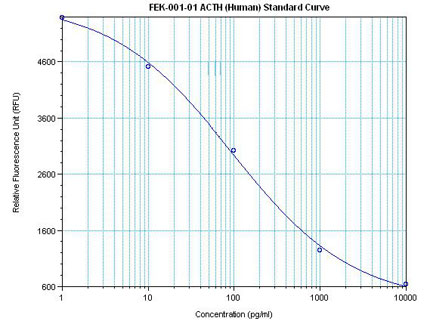|
|
|
ACTH (Adrenocorticotropic hormone) |
ACTH and its fragments play important roles in the regulation of feeding. |
Adrenocorticotropic hormone (ACTH), also known as corticotropin, is a polypeptide tropic hormone produced and secreted by the anterior pituitary gland. It is an important component of the hypothalamic-pituitary-adrenal axis and is often produced in response to biological stress (along with corticotropin-releasing hormone from the hypothalamus). Its principal effects are increased production and release of corticosteroids and, as its name suggests, cortisol from the adrenal cortex.
ACTH is synthesized from pre-pro-opiomelanocortin (pre-POMC). The removal of the signal peptide during translation produces the 241-amino acid polypeptide POMC, which undergoes a series of post-translational modifications such as phosphorylation and glycosylation before it is proteolytically cleaved by endopeptidases to yield various polypeptide fragments with varying physiological activity. These fragments include NPP, Melanotropin Gamma (γ-MSH), Potential Peptide, Corticotropin (Adrenocorticotropic Hormone, or ACTH), Melanotropin Alpha (Melanocyte-Stimulating Hormone, or α-MSH), Corticotropin-like Intermediate Peptide (CLIP), Lipotropin Beta (β-LPH), Lipotropin Gamma (γ-LPH), Melanotropin Beta (β-MSH), Beta-Endorphin, and Met-Enkephalin. POMC, ACTH and β-lipotropin are secreted from corticotropes in the anterior lobe (or adenohypophysis) of the pituitary gland in response to the hormone corticotropin-releasing hormone (CRH) released by the hypothalamus.
In order to regulate the secretion of ACTH, many substances secreted within this axis exhibit slow/intermediate and fast feedback-loop activity. Glucocorticoids secreted from the adrenal cortex work to inhibit CRH secretion by the hypothalamus, which in turn decreases anterior pituitary secretion of ACTH. Glucocorticoids may also inhibit the rates of POMC gene transcription and peptide synthesis. The latter is an example of a slow feedback loop, which works on the order of hours to days, whereas the former works on the order of minutes.
ACTH is also related to the circadian rhythm in many organisms. The half-life of ACTH in human blood is about ten minutes.
We investigated the central effect of ACTH 1-39 (ACTH) and peptides derived from the N-terminus (ACTH 1-10, Acetyl-ACTH 1-13-amide [alpha-MSH]) and C-terminus (ACTH 18-39 and ACTH 22-39) of this peptide on feeding in 16 hour-fasted or rats fed ad libitum.
As expected, ACTH reduced feeding in fed and previously fasted rats, although this anorectic effect was more pronounced in fasted rats. The N-terminal-derived peptide alpha-MSH, but not ACTH 1-10, reduced cumulative food intake over 2 h after its injection intracerebroventricularly (icv) in 16 h-fasted, but not in fed rats.
In contrast, the C-terminal fragments produced a long-lasting increase in feeding in fasted, but not in fed rats. The anorectic effects of N-terminal fragments of ACTH are recognised to be mediated via melanocortin MC4 receptors. However, the orexigenic effects of the C-terminal fragments do not appear to be conducted via MC4 receptors, since neither ACTH 18-39 nor ACTH 22-39 stimulated cAMP accumulation nor inhibited the ACTH-stimulated cAMP accumulation in HEK-293 cells transfected with the recombinant MC4 receptor.
Al-Barazanji et al. Horm Metab Res. 2001 Aug;33(8):480-5.
| Tissue
Sample |
Rat brain tissue |
| Fixative |
10% Formalin |
| Embedding |
Paraffin |
| Negative
control |
No primary antibody |
|
Pretreatment |
Intact |
| Blocking |
2% Normal Goat Serum |
| Primary
Antibody |
Rabbit Anti-ACTH (H)
Serum (Catalog No.:H-001-01) |
| Optimal
Dilution |
1:500 (Overnight at 4
o C) |
| Secondary
Antibody |
Goat anti-Rabbit IgG,
Biotinylated (1:400, 30 min) |
|
Amplification |
ABC (Vector) (1:400,
30 min) |
| Detection
system |
HRP |
| Substrate |
DAB (Sigma), 3 min |
|

| Tissue
Sample |
Mouse brain tissue
homogenate (reduce condition) |
|
Electrophoresis |
10% SDS-PAGE gel |
| Negative
control |
No primary antibody |
| Blocking |
1% BSA in TBST or 5%
dry milk in TBST |
| Primary
Antibody |
Rabbit Anti-ACTH (H)
Antiserum (Catalog No.:H-001-01) |
| Optimal
Dilution |
1:400 ( overnight at
4oC) |
| Secondary
Antibody |
Donkey anti-Rabbit
IgG whole (H+L), HRP conjugate(1:5000, 30 min) |
| Detection system |
HRP |
| Substrate |
SuperSignal
Chemiluminescent Substrate |
|


|

|

|
Linear Range: 0.12-1.78 ng/ml |
Linear Range: 42.7-1828 pg/ml
2.8 times more sensitive than normal EIA kits
|
|

|

|  |
Linear Range: 0.08-1.78ng/ml |
Linear Range: 28.3-400 pg/ml
2.8 times more sensitive than normal EIA kits
|
Linear Range: 12.8 - 268 pg/ml
6 times more sensitive than normal EIA kits
|
|
|
|
%ACTH%
|
|
|


